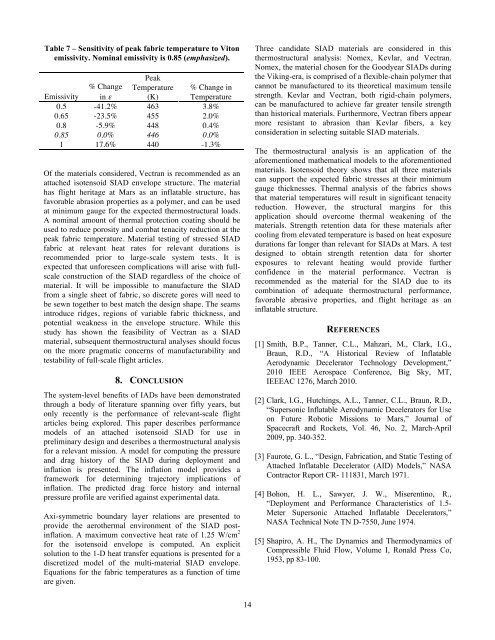Thermal, Structural, and Inflation Modeling of an Isotensoid ...
Thermal, Structural, and Inflation Modeling of an Isotensoid ...
Thermal, Structural, and Inflation Modeling of an Isotensoid ...
You also want an ePaper? Increase the reach of your titles
YUMPU automatically turns print PDFs into web optimized ePapers that Google loves.
Table 7 – Sensitivity <strong>of</strong> peak fabric temperature to Viton<br />
emissivity. Nominal emissivity is 0.85 (emphasized).<br />
Emissivity<br />
Peak<br />
Temperature<br />
(K)<br />
% Ch<strong>an</strong>ge<br />
in ε<br />
0.5 -41.2% 463 3.8%<br />
0.65 -23.5% 455 2.0%<br />
0.8 -5.9% 448 0.4%<br />
0.85 0.0% 446 0.0%<br />
1 17.6% 440 -1.3%<br />
% Ch<strong>an</strong>ge in<br />
Temperature<br />
Of the materials considered, Vectr<strong>an</strong> is recommended as <strong>an</strong><br />
attached isotensoid SIAD envelope structure. The material<br />
has flight heritage at Mars as <strong>an</strong> inflatable structure, has<br />
favorable abrasion properties as a polymer, <strong><strong>an</strong>d</strong> c<strong>an</strong> be used<br />
at minimum gauge for the expected thermostructural loads.<br />
A nominal amount <strong>of</strong> thermal protection coating should be<br />
used to reduce porosity <strong><strong>an</strong>d</strong> combat tenacity reduction at the<br />
peak fabric temperature. Material testing <strong>of</strong> stressed SIAD<br />
fabric at relev<strong>an</strong>t heat rates for relev<strong>an</strong>t durations is<br />
recommended prior to large-scale system tests. It is<br />
expected that unforeseen complications will arise with fullscale<br />
construction <strong>of</strong> the SIAD regardless <strong>of</strong> the choice <strong>of</strong><br />
material. It will be impossible to m<strong>an</strong>ufacture the SIAD<br />
from a single sheet <strong>of</strong> fabric, so discrete gores will need to<br />
be sewn together to best match the design shape. The seams<br />
introduce ridges, regions <strong>of</strong> variable fabric thickness, <strong><strong>an</strong>d</strong><br />
potential weakness in the envelope structure. While this<br />
study has shown the feasibility <strong>of</strong> Vectr<strong>an</strong> as a SIAD<br />
material, subsequent thermostructural <strong>an</strong>alyses should focus<br />
on the more pragmatic concerns <strong>of</strong> m<strong>an</strong>ufacturability <strong><strong>an</strong>d</strong><br />
testability <strong>of</strong> full-scale flight articles.<br />
8. CONCLUSION<br />
The system-level benefits <strong>of</strong> IADs have been demonstrated<br />
through a body <strong>of</strong> literature sp<strong>an</strong>ning over fifty years, but<br />
only recently is the perform<strong>an</strong>ce <strong>of</strong> relev<strong>an</strong>t-scale flight<br />
articles being explored. This paper describes perform<strong>an</strong>ce<br />
models <strong>of</strong> <strong>an</strong> attached isotensoid SIAD for use in<br />
preliminary design <strong><strong>an</strong>d</strong> describes a thermostructural <strong>an</strong>alysis<br />
for a relev<strong>an</strong>t mission. A model for computing the pressure<br />
<strong><strong>an</strong>d</strong> drag history <strong>of</strong> the SIAD during deployment <strong><strong>an</strong>d</strong><br />
inflation is presented. The inflation model provides a<br />
framework for determining trajectory implications <strong>of</strong><br />
inflation. The predicted drag force history <strong><strong>an</strong>d</strong> internal<br />
pressure pr<strong>of</strong>ile are verified against experimental data.<br />
Axi-symmetric boundary layer relations are presented to<br />
provide the aerothermal environment <strong>of</strong> the SIAD postinflation.<br />
A maximum convective heat rate <strong>of</strong> 1.25 W/cm 2<br />
for the isotensoid envelope is computed. An explicit<br />
solution to the 1-D heat tr<strong>an</strong>sfer equations is presented for a<br />
discretized model <strong>of</strong> the multi-material SIAD envelope.<br />
Equations for the fabric temperatures as a function <strong>of</strong> time<br />
are given.<br />
Three c<strong><strong>an</strong>d</strong>idate SIAD materials are considered in this<br />
thermostructural <strong>an</strong>alysis: Nomex, Kevlar, <strong><strong>an</strong>d</strong> Vectr<strong>an</strong>.<br />
Nomex, the material chosen for the Goodyear SIADs during<br />
the Viking-era, is comprised <strong>of</strong> a flexible-chain polymer that<br />
c<strong>an</strong>not be m<strong>an</strong>ufactured to its theoretical maximum tensile<br />
strength. Kevlar <strong><strong>an</strong>d</strong> Vectr<strong>an</strong>, both rigid-chain polymers,<br />
c<strong>an</strong> be m<strong>an</strong>ufactured to achieve far greater tensile strength<br />
th<strong>an</strong> historical materials. Furthermore, Vectr<strong>an</strong> fibers appear<br />
more resist<strong>an</strong>t to abrasion th<strong>an</strong> Kevlar fibers, a key<br />
consideration in selecting suitable SIAD materials.<br />
The thermostructural <strong>an</strong>alysis is <strong>an</strong> application <strong>of</strong> the<br />
aforementioned mathematical models to the aforementioned<br />
materials. <strong>Isotensoid</strong> theory shows that all three materials<br />
c<strong>an</strong> support the expected fabric stresses at their minimum<br />
gauge thicknesses. <strong>Thermal</strong> <strong>an</strong>alysis <strong>of</strong> the fabrics shows<br />
that material temperatures will result in signific<strong>an</strong>t tenacity<br />
reduction. However, the structural margins for this<br />
application should overcome thermal weakening <strong>of</strong> the<br />
materials. Strength retention data for these materials after<br />
cooling from elevated temperature is based on heat exposure<br />
durations far longer th<strong>an</strong> relev<strong>an</strong>t for SIADs at Mars. A test<br />
designed to obtain strength retention data for shorter<br />
exposures to relev<strong>an</strong>t heating would provide further<br />
confidence in the material perform<strong>an</strong>ce. Vectr<strong>an</strong> is<br />
recommended as the material for the SIAD due to its<br />
combination <strong>of</strong> adequate thermostructural perform<strong>an</strong>ce,<br />
favorable abrasive properties, <strong><strong>an</strong>d</strong> flight heritage as <strong>an</strong><br />
inflatable structure.<br />
REFERENCES<br />
[1] Smith, B.P., T<strong>an</strong>ner, C.L., Mahzari, M., Clark, I.G.,<br />
Braun, R.D., “A Historical Review <strong>of</strong> Inflatable<br />
Aerodynamic Decelerator Technology Development,”<br />
2010 IEEE Aerospace Conference, Big Sky, MT,<br />
IEEEAC 1276, March 2010.<br />
[2] Clark, I.G., Hutchings, A.L., T<strong>an</strong>ner, C.L., Braun, R.D.,<br />
“Supersonic Inflatable Aerodynamic Decelerators for Use<br />
on Future Robotic Missions to Mars,” Journal <strong>of</strong><br />
Spacecraft <strong><strong>an</strong>d</strong> Rockets, Vol. 46, No. 2, March-April<br />
2009, pp. 340-352.<br />
[3] Faurote, G. L., “Design, Fabrication, <strong><strong>an</strong>d</strong> Static Testing <strong>of</strong><br />
Attached Inflatable Decelerator (AID) Models,” NASA<br />
Contractor Report CR- 111831, March 1971.<br />
[4] Bohon, H. L., Sawyer, J. W., Miserentino, R.,<br />
“Deployment <strong><strong>an</strong>d</strong> Perform<strong>an</strong>ce Characteristics <strong>of</strong> 1.5-<br />
Meter Supersonic Attached Inflatable Decelerators,”<br />
NASA Technical Note TN D-7550, June 1974.<br />
[5] Shapiro, A. H., The Dynamics <strong><strong>an</strong>d</strong> Thermodynamics <strong>of</strong><br />
Compressible Fluid Flow, Volume I, Ronald Press Co,<br />
1953, pp 83-100.<br />
14
















